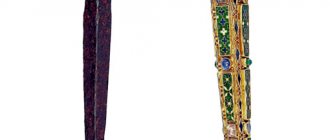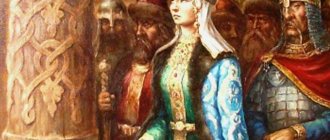Cross of Euphrosyne of Polotsk
A unique work of applied art of this time is the cross of Euphrosyne of Polotsk. The cross is considered the most important symbol of Christianity, which expresses the highest sacred values: the ascension of the spirit, the desire for God, eternity, and is a model of existence and man in it.
By order of Euphrosyne in 1161, Lazar Bogsha created the Cross-ark to store Christian relics sent from Constantinople and Jerusalem. The master made the altar cross six-pointed. Its shape symbolizes the Universe created by God in six days.
The basis of the cross was cypress wood, from which especially valuable religious objects were made. The relic measures 51.8 cm in height, the length of the top crossbar is 14, the bottom is 21, the thickness is 2.5 cm, the top and bottom of the tree were covered with 21 gold plates with precious stones, ornaments and 20 enamel plates representing the faces of saints.
At the upper ends of the Cross, the master placed half-length images of Christ, the Virgin Mary, and John the Baptist. In the center of the lower crosshair are images of the four evangelists John, Luke, Mark and Matthew, and at the ends are the archangels Gabriel and Michael. Below are the heavenly patrons of Euphrosyne and her parents - Euphrosyne of Alexandria, George and Sophia.
On the reverse side of the Cross there are images of the church fathers John Chrysostom, Basil the Great, Gregory the Theologian, the Apostles Peter and Paul, as well as Saints Stephen, Demetrius and Panteleimon.
Above each icon there are inscriptions in Greek and Slavic letters. In the middle of the Cross, in five signature square nests, there were Christian relics: pieces of the Cross of the Lord with drops of the Blood of Jesus, a piece of stone from the Tomb of the Virgin Mary, pieces of the relics of Saints Stephen and Panteliimon and the blood of Saint Demetrius.
The sides of the Cross are lined with 20 silver plates with gilding, and along the perimeter of the front side of the Cross there is a pearl outline. The most valuable of the Christian relics placed in nests are pieces of the Holy Tree - the Cross on which Christ was crucified.
According to the customer’s plan, this shrine should forever “give life” to the souls of Polotsk residents and all believers. In terms of its execution technique, the Cross is a masterpiece of world significance, one of the few dated monuments of applied art of the 12th century.
Icons of the holy ascetic
The most ancient images of St. Euphrosyne include a fresco located on one of the pillars of the Transfiguration Church of the St. Euphrosyne Monastery in Polotsk, as well as a small icon included in the top row of the iconostasis in the Smolensk Cathedral of the Novodevichy Convent. In this portrait the Saint is captured at the moment of reading a prayer, in a robe and in a doll.
At the beginning of the 19th century, a large canvas appeared, which is today in the church of the Spassky Monastery in Polotsk. It shows the abbess standing in her cell next to a table with books. In her left hand you can see the famous cross created by the jeweler Bogsha, and her right palm is directed towards the princely regalia. The gaze of the great righteous woman is directed upward.
There are several images of Saint Euphrosyne in the Kiev Pechersk Lavra, where the incorrupt relics remained for a long time. The image of the enlightener is also present in the composition “Cathedral of the Kiev-Pechersk Saints”.
Loss of the cross
This miracle of craftsmanship and beauty became a sign of Divine patronage over Belarus, a symbol of the high spirituality of the Polotsk land. History of the Cross in the 20th century. filled with detective content.
In 1921, the Cross was requisitioned by the Soviet authorities; for some time it was in the Minsk museum, but already in 1929 it was transported to Mogilev. On November 21, 1929, an act was drawn up for the transfer of Lazar Boschi’s creation from the Minsk Museum to the Mogilev Museum.
In Mogilev, the shrine was placed in a museum exhibition, but visitors prayed near the Cross. For this reason, it was transferred to the former land bank. According to the official version, it was from here that he was stolen by the Nazi invaders in 1941.
There are other versions. As if the Cross came to the east and that it was sold after the war at an auction overseas. The search for this Cross was carried out more than once; they searched in Europe, America, in the collections of Morgan and Rockefeller; diplomatic services, famous Belarusian scientists, and Interpol specialists were involved in the search. But the Cross has not yet been found.
Temples and monuments
The largest number of churches of St. Euphrosyne of Polotsk is in Belarus. Also, churches built in honor of this outstanding woman function in Russia, Ukraine, Poland, and Lithuania. You can visit the churches of the great ascetic in Russian Kuntsevo, St. Petersburg, Novosibirsk, Kyiv, Bialystok, Vilnius.
All over the world there are many monuments to the outstanding abbess, who is considered one of the first enlighteners of Eastern Europe. There are two monuments in Minsk dedicated to this Saint. The first, located near the Belarusian State University, was created in 1999. The second is located near the Agat research and production association. This composition, erected in 2002, is considered the most interesting and original. Many tourists and pilgrims arriving in the capital of Belarus strive to see it.
Story
Image of a cross on a coin of the National Bank of Belarus.
Design: S. Zaskevich, 2007 The cross was created in 1161 by order of the daughter of the Polotsk prince Svyatoslav Vseslavich, the granddaughter of Vseslav Bryachislavich Predslava (in the monastic life of Euphrosyne) by the Polotsk master jeweler Lazar Bogsha[3]. At the request of Euphrosyne, the Byzantine Emperor Manuel Komnenos and Patriarch Luke Chrysovers sent some shrines for the cross[5].
Until the 13th century, the cross was kept in Polotsk, and after it was captured by the Smolensk prince Mstislav Davydovich on January 17, 1222, it was transported to Smolensk, where it remained until the beginning of the 16th century. In 1495, a copy of the cross was made in Smolensk, which was necessary in order not to lower the valuable cross into the water during the blessing of water[5].
“When the God-loving Tsar and Grand Duke, thinking of going against the apostates of the Christian faith in godless Lithuania, then in his royal treasury the cross of Polotsk was decorated with gold and precious stones... The Netsy will tell: in the past, once upon a time, the Smolnyan and Polotsk residents held their sovereign princes for to their own wills, and among themselves the Smolnians from Polotsk fought, and the Smolnians in Polotsk took that honorable cross in the war and brought it to Smolensk; When the pious sovereign Prince the Great Vasily Ivanovich took his entire Russian patrimony of Smolensk, then that honorable cross was brought to the reigning city of Moscow. The Tsar and Grand Duke ordered that cross to be renewed and decorated. And taking that cross with you and, having hope in a merciful God and in the power of the cross, defeating your enemies, even if they were.”[5].
Mention of the cross of Euphrosyne of Polotsk in the Nikon Chronicle under 1563
In 1514, Vasily III, having captured Smolensk, took the cross to Moscow. As a great treasure and a military trophy, the relic ended up not in the metropolitan, but in the royal treasury and was rarely used in worship on the biggest holidays. In addition, the cross was restored in Moscow[5].
The devout Ivan the Terrible, believing in the “power of the cross” of the Polotsk cross (like many other relics), took it on a campaign against Polotsk in 1563, apparently vowing that he would return the cross to its original place in case of victory. This was done, despite the high value of the cross[5].
In 1579, Polotsk was taken by the King of Poland and Grand Duke of Lithuania Stefan Batory. Fearing looting by Batory's troops, Orthodox monks hid the relic. After the discovery, the cross was transferred to St. Sophia Cathedral, which after the Brest Church Union was transferred to the Uniates. The Uniates, like the Orthodox, revered this relic[5]. Uniate Archimandrite Ignatius Kulchinsky, who studied the cross, wrote:
| As a doctor of philosophy in our monastery, I often observed how the memory of this shrine was honored by the nuns of our monastery and the residents of Polotsk, as well as a fairly large voivodeship. In the cathedral church of Polotsk, a golden cross of magnificent work with various relics is still kept [5]. |
During Napoleon's Russian campaign of 1812, for safety purposes, the Basilians built the cross into the wall, and with the end of the war they returned it to the cathedral[5]. After the liquidation of the union in the Russian Empire in 1839, the relic again passed to the Orthodox. In 1841, Bishop Vasily Luzhinsky took the cross to Moscow and St. Petersburg for veneration. After a stay in Moscow and St. Petersburg, the relic was returned to Polotsk and placed in the cathedral of the Spaso-Efrosinevsky Monastery (that is, in the temple for which the cross was made)[5].
In 1928, the cross was transported from Polotsk to Minsk, and in 1929 to Mogilev as an exhibit of the Mogilev Historical Museum. According to some sources, it was kept in the safe room of the Mogilev regional committee and the city party committee[5], according to others - in the safe room of the museum itself[6].
The cross was lost during the Great Patriotic War and has not been found to this day. At the same time, in 1943 and 1945, Secretary of the Central Committee of the Communist Party of Belarus Panteleimon Ponomarenko twice publicly spoke about the cross as an object of art that was not lost, but was at the disposal of the USSR leadership. However, according to the recollections of the daughter of cabinetmaker Yakov Orlov from the village of Nedashevo, Mogilev region, in early July 1941, Ponomarenko brought two suitcases with his car for safekeeping. After the war he came for them, but in February 1943 the Germans destroyed the house and killed Orlov’s entire family. The commandant of the Berlin Palace came to
accompanied by three cars, they probably removed all the hidden valuables from the Mogilev Museum. Including the cross.][7].
In 1990, the UN made an attempt to find the cross in the United States[8].
In order not to miss one subtlety
You have already noticed that in the period 1922-1928, the cross, along with other church valuables, was “lying” in the provincial financial department. It was not the revolutionary sailor and Red Army soldier who was sent to search for him, but the academician, historian and head of the state museum Vaclav Lastovsky. In other words, a person who saw the subject of the search with his own eyes.
If you carefully read his description of the found relic, published in “Records,” it contains a lot of interesting details. As an experienced expert and collector of museum valuables, Lastovsky could not help but know that Lazar Bogsha made a cross from cypress. Meanwhile, in the act of transferring the relic it is written in black and white that it is made of oak. The scientist also records repeated facts of replacing precious stones with colored glasses.
As a religious and intelligent man, Lastovsky also probably did not go against the curse of the cross and decided not to make too much noise about the outright forgery. It is possible that the precious stones were “picked out” by representatives of the new government, guided by Lenin’s call “Rob the loot!” On the other hand, where did these people with a parochial education get exact copies of the jewelry and how were they able to insert them? An experienced jeweler is needed here.
The copy version looks more plausible from this point of view. Here we must take into account that the emigrant press of that time published reports about the presence of a similar or similar Polotsk cross in one of the churches in Poland. So, Vera Petrovna’s story is true?
What to pray to the great righteous woman
During her lifetime, Saint Euphrosyne was famous for her many benefactors, her desire to pacify conflicts, and to educate not only rich, but also poor people. In their prayers, Orthodox Christians ask her:
- about ending hostility;
- about the destruction of intrigues;
- about sending peace in the family;
- about the gift of wisdom, new ideas;
- about giving strength in the study of various sciences.
Akathist to Euphrosyne of Polotsk helps to protect oneself from enemies, slander, and unfounded claims. Parents turn to the saint with requests to enlighten their children who do not have the zeal to study. They pray to the outstanding ascetic for strengthening her faith, the ability to resist temptations, and for the mercy of God, without which not a single sphere of human activity can flourish.
Recreation
Recreated cross, 2010
| External images |
The first stamp of the Republic of Belarus depicting the ancient cross of Euphrosyne of Polotsk. 1992
During the celebration of the millennium of the Polotsk diocese and the Orthodox Church in Belarus in 1992, it was decided to recreate the cross. The work was blessed by the Patriarch of Jerusalem Diodorus and the Patriarchal Exarch of All Belarus, Metropolitan Philaret. The reconstruction of the cross was entrusted to the Brest enamel jeweler, member of the Union of Artists of Belarus Nikolai Petrovich Kuzmich. On August 24, 1997, Metropolitan Philaret consecrated a copy of the cross of Euphrosyne of Polotsk, which is currently kept in the Transfiguration Church of the Polotsk Spaso-Euphrosyne Convent.
Notes
- Batyushkov P.I.
Belarus and Lithuania. Historical destinies of the North-Western region. - St. Petersburg, 1889. - Sementovsky A. M.
Chapter VII. Ancient church objects. // Belarusian antiquities. - St. Petersburg: Typo-lithography by N. Stepanov, 1890. - P. 125. - 137 p. — 600 copies. - ↑ 12345
845 years of the Cross of Euphrosyne of Polotsk Archival copy dated October 8, 2012 on the Wayback Machine // Central library system of the city of Polotsk. — 2006, December. (Retrieved December 16, 2010) - Inscription on the roof of the ancestral Efrasinna of Polatsk (1161) Archival copy dated May 14, 2011 on the Wayback Machine. Website “History of Belarus IX-XVIII centuries. Pershakrynitsy." (Retrieved March 12, 2011)
- ↑ 1 2 3 4 5 6 7 8 9 10 Alekseev L.V.
Cross of St. Euphrosyne of Polotsk (inaccessible link) // Russian Archeology, No. 2. - 1993. (Retrieved December 16, 2010 ) - Mogilev Regional Museum of Local Lore (unspecified)
(inaccessible link). Access date: April 17, 2011. Archived February 10, 2012. - Sergey Krapivin.
Belarus-1945. Cross of Euphrosyne of Polotsk and Panteleimon Ponomarenko // News site “Naviny.by”, May 30, 2010. (Retrieved December 16, 2010) - Maldis A.I.
Appearance of the Slutsk Gospel Archived copy of March 4, 2021 on the Wayback Machine // Website of the newspaper “Soviet Belarus”, May 28, 2008. (Verified December 16, 2010)










